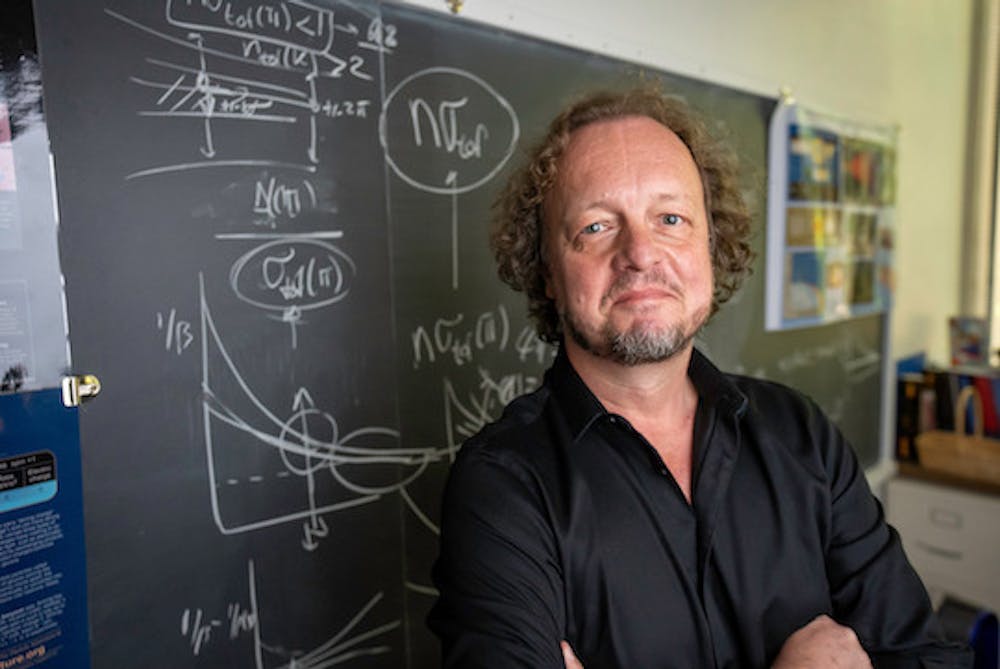Frank Geurts to lead world’s longest running nuclear collider experiment

Rice University physicist Frank Geurts has been named co-spokesperson for the Solenoidal Tracker at Relativistic Heavy Ion Collider collaboration, the world’s first heavy-ion collider located at Brookhaven National Laboratory. Alongside Brookhaven Lab physicist Lijuan Ruan, Geurts will lead STAR for the next three years to collect data on nuclear collisions and study the matter that was present at the origin of the universe.
“The neutrons and protons inside atoms melt into their substructure: quarks and gluons,” Geurts said. “We slam nuclei to smithereens and look at what comes out of it. [We] deduce what we had in [early universe] conditions.”
The STAR experiment can replicate the extreme conditions that existed just microseconds after the Big Bang with detailed control over the data collected.
“In the lab, you can have these kinds of collisions many, many times. You can study the conditions and properties created in a lab in a very detailed way,” Ruan said.
For Geurts, these questions surfaced in his life earlier than most. The Netherlands-born scientist can trace his love for physics back to the stars.
“As a kid, I was always very interested in astronomy. I woke up at two o’clock in the morning, looking at the stars,” Geurts said. “The rabbit hole was there, I just went deeper and deeper, and figured that nuclear particle physics was my thing. There was this drive in asking, I went from the large objects in the sky to zooming in and understanding why things are what they are.”
Geurts went on to study physics in his undergraduate and graduate years in the Netherlands. During that time, Geurts had the opportunity to work at CERN, the European Organization for Nuclear Research, before applying for a postdoctoral position at Rice and beginning his involvement with STAR.
“I [selected] Rice because [of] its reputation in designing, development and research in detectors for particle physics,” Geurts said. “I grew into [the STAR] experiment. I was a co-convener, then I was a Physics Analysis Coordinator, then I was a deputy spokesperson and as of recently, I am, together with Lijuan, a co-spokesperson.”
Ramamoorthy Ramesh, Rice’s vice president of research, emphasized the significance of Rice’s affiliation with STAR.
“At the end of the day, you want our faculty to be competing for the biggest discoveries. And the biggest discoveries invariably mean the biggest recognition,” Ramesh said. “We need to be a part of that big conversation, where discoveries are being made.”
Ramesh analogizes the scope of scientific discovery to the vastness of a boba tea shop menu.
“The origins are still being discovered. In the beginning there were just protons, electrons, neutrons,” Ramesh said. “Now, we know there are maybe 33 subatomic particles, with different flavors. It’s exactly like going to a boba tea shop. It’s just tea with boba, but there are 60 different varieties.”
The public funding that the STAR collaboration relies on requires its findings to be communicated to the general public.
“We’re the longest running nuclear colliding experiment. That is, to a substantial degree, thanks to taxpayers. We need to make sure that high school kids, undergrads and middle school [students] know the science so they can have the same enthusiasm we have,” Geurts said.
STAR plans to record its final collisions in 2025, before being converted into an electron-ion collider. However, STAR’s work will continue after its last collision.
“STAR will likely continue another five or eight years just digesting and analyzing,” Geurts said. “We basically redesign a new experiment each time we look at the data.”
From a curiosity in the stars to colliding particles at super speeds, for Geurts, all discoveries come back to collaboration.
“To students that want to make big discoveries, talk about science,” Geurts said. “Discuss it with your peers, with your professors, discuss it with your parents for all I care. Big discoveries come not out of single minds. Big discoveries come out of humans talking to each other.”
More from The Rice Thresher

Rice to support Harvard in lawsuit against research funding freeze
Rice, alongside 17 other research universities, filed an amicus curiae brief in support of Harvard University’s lawsuit against the Trump administration over more than $2 billion in frozen research grants.

Mayor Whitmire discusses ‘the state of Houston’ between audience protests at Baker Institute
John Whitmire’s remarks on the city’s budget, transportation and infrastructure were interrupted twice by shouts from audience members at a Baker Institute event May 29. At the event, which was open to the public, Whitmire spoke about the current state of Houston alongside former county judge Ed Emmett.
Rice reaffirms support for international students after Trump administration targets Harvard
Rice and the Office of International Students and Scholars said in a May 23 email that they are monitoring the Trump administration’s actions towards Harvard to bar the school from enrolling international students. A federal judge temporarily halted the move less than 24 hours later.


Please note All comments are eligible for publication by The Rice Thresher.